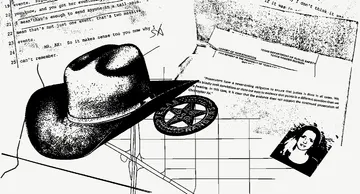When I need to go to my local supermarket, I suit up with latex gloves I got from Target and my wannabe N95 mask. (Really, I just wear my sleep mask over my nose and mouth.) When I get home, I clean my groceries with disinfecting wipes, put my clothes in the wash, take a shower. Only then do I allow myself to make physical contact with my wife and sons.
It’s not ideal. But I am not as anxious as you may be during the coronavirus crisis, because not so long ago I had to survive with less. I spent 27 years in prison, a sentence that began when I was 17 years old. And if there’s one thing people who spent a long time in prison have acquired, it’s the ability to adapt.
Now I am falling back on my old prison survival habits. While my neighbors are running to the grocery store for the last of the toilet paper, hand sanitizer and canned goods, I am unbothered by the idea of running out—I have made do before. I gladly take the full 20 seconds to wash my hands with the warm water I was deprived of for 27 years. And I’m stocked up on my prison-survival kit: peanut butter and grape jelly.
Self-quarantine is similar to being in what New York prisons call keeplock. Like with solitary confinement, you must spend 23 hours a day alone in your cell. The big difference is that in keeplock you get to keep all of your property with you. This includes personal food purchased from the commissary, all of your underwear and shirts, and, if you have them, your books, radio and television.
My first time in keeplock came when an officer who searched my cell found a large bottle of garlic powder I purchased from the mess-hall black market. This was not a press conference-worthy drug bust, but don’t tell the correctional officer who made it. He treated me like I was El Chapo when all I wanted was to flavor my food. I was keeplocked many other times for situations that ranged from having a bucket on my floor to not complying with a surprise search.
So I’ve seen a version of coronavirus-related panic before. In my early years inside, keeplocks were the catalyst for deep depression. I wanted to go to the yard, gym, mess hall and work. I didn’t want to be alone. I was already away from my family, and freedom at large, which opened up a bag of thoughts about bad choices, remorse and the unfairness of the criminal justice system.
In time, the school at Sing Sing Correctional Facility, where I did most of my time, became a major mental outlet for me. Every interaction with my college professors had deep implications for my self-esteem. It meant that I was intellectually adequate. It augmented my personal value and helped me believe that I was the aggregate of all my actions—not just my crime.
Sometimes the school building would close because of a riot, escape drills or a facility-wide search. It was always a major blow. Now schools are shuttered across the country, as they are in several New York State prisons, including the one I left.
Social distancing is also sadly familiar. Prison yards have a “six-to-a-group” rule. Hanging out with even one more person can draw a misbehavior report that could result in keeplock or the loss of privileges such as recreation, commissary, phone time and packages from home.
The four times I landed in solitary confinement, our one hour of fresh-air-socializing was conducted in “rec pens.” In Upstate Correctional Facility, where I spent six months, the rec pens are grouped like a honeycomb—small cages stacked on top of each other in rows. This is where I learned to share supplies with people without making physical contact—another skill that comes in handy right now. It’s impossible for me to feel impolite about dropping off my gardening tools at my neighbor’s door when I’ve bartered stamps for food with people 70 yards away.
To make trades, we would take string that we’d pulled from our fraying blankets and tie it to the spear-shaped kites we’d made out of magazine or newspaper pages. I would affix my envelope of stamps to the string, wrist-flick the kite through the small opening in my rec-pen gate, and watch it soar in the wind. After it got entangled with the kite my partner had cast, he’d reel in the lines, remove the stamps and return the line with a few slices of bread, a fruit cup or matzo crackers tied to it. We used a similar fishing system during the 23 hours we’d spend locked inside our cells.
Many nights I survived off of cold pie I made with my bartered bread mashed up with milk and filled with a week’s worth of fruit cups. On the outside, where I occasionally share rum cakes, all I have to do is send you a text that tells you to come out of your front door and pick up this treat I left for you and your family.
Today I am free. Been that way for 22 months. Still, I am confined to my house, with the obvious free-world shelter-in-place advantages like more space, Netflix, social media, unlimited calls, Zoom video calls, online social gatherings, etc. And being with my family.
B.C.—Before COVID-19—I never thought I’d be keeplocked again. But coronavirus has other plans.
